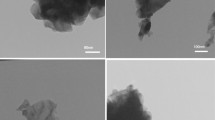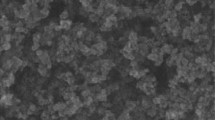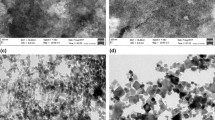Abstract
This study investigates the viscosity of CuO/EG:W (20:80 v/v) nanofluid in the solid volume fraction from 0 to 1% and temperatures between 15 and 50 °C. Examining the correlation between the shear stress and shear rate obtained from experiment test at different temperatures and solid volume fractions revealed that the investigated nanofluid behaves much very carefully like the Newtonian fluid behavior. Therefore, observing the independency of the viscosity to the shear rate was not unexpected in the results. During analyzing, the authors found that the viscosity of investigated nanofluid has a very low sensitivity to temperature changes but it is significantly influenced by changes in the solid volume fraction and nanoparticle concentration. In this research, a new experimental correlation was suggested to predict the viscosity of the investigated nanofluid in the expressed range of temperature and solid volume fraction to model the test results. In the mentioned correlation, the viscosity is expressed as the relative variable to independent variables (temperature and solid volume fraction). R2 (R-squared) value for the expressed correlation was 0.9850, which shows the accuracy in the presented experimental correlation to predict the nanofluid viscosity in the concentration and the temperature range.













Similar content being viewed by others
References
Esfe MH, Razi P, Hajmohammad MH, Rostamian SH, Sarsam WS, Arani AAA, Dahari M. Optimization, modeling and accurate prediction of thermal conductivity and dynamic viscosity of stabilized ethylene glycol and water mixture Al2O3 nanofluids by NSGA-II using ANN. Int Commun Heat Mass Transf. 2017;82:154–60.
Esfe MH, Esfandeh S, Saedodin S, Rostamian H. Experimental evaluation, sensitivity analyzation and ANN modeling of thermal conductivity of ZnO–MWCNT/EG–water hybrid nanofluid for engineering applications. Appl Therm Eng. 2017;125:673–85.
Esfe MH. Designing a neural network for predicting the heat transfer and pressure drop characteristics of Ag/water nanofluids in a heat exchanger. Appl Therm Eng. 2017;126:559–65.
Esfe MH, Alirezaie A, Rejvani M. TTTd alterations gradient of thermal conductivity increases with the rise of volume fraction of up to 1%, and emmmy then, the sensitivity decreases. Generally, the current study is a combination of empirical studies along. Appl Therm Eng. 2017;111:1202–10.
Esfe MH, Behbahani PM, Arani AAA, Sarlak MR. Thermal conductivity enhancement of SiO2–MWCNT (85:15%)–EG hybrid nanofluids. J Therm Anal Calorim. 2017;128(1):249–58.
Alirezaie A, Hajmohammad MH, Ahangar MRH, Esfe MH. Price-performance evaluation of thermal conductivity enhancement of nanofluids with different particle sizes. Appl Therm Eng. 2018;128:373–80.
Esfe MH, Esfandeh S, Rejvani M. Modeling of thermal conductivity of MWCNT-SiO 2 (30: 70%)/EG hybrid nanofluid, sensitivity analyzing and cost performance for industrial applications. J Therm Anal Calorim. 2018;131(2):1437–47.
Esfe MH, Amiri MK, Alirezaie A. Thermal conductivity of a hybrid nanofluid. J Therm Anal Calorim. 1–10 (in press).
Raei B, Shahraki F, Jamialahmadi M, Peyghambarzadeh S. Experimental investigation on the heat transfer performance and pressure drop characteristics of γ-Al2O3/water nanofluid in a double tube counter flow heat exchanger. Transp Phenom Nano Micro Scales. 2016;5(1):64–75. https://doi.org/10.7508/tpnms.2017.01.007.
Abbasian Arani A, Abbaszadeh M, Ardeshiri A. Mixed convection fluid flow and heat transfer and optimal distribution of discrete heat sources location in a cavity filled with nanofluid. Transp Phenom Nano Micro Scales. 2016;5(1):30–43. https://doi.org/10.7508/tpnms.2017.01.004.
Esfe MH, Zabihi F, Rostamian H, Esfandeh S. Experimental investigation, model development of the non-Newtonian behavior of CuO-MWCNT-10w40 nano-lubricant for lubrication purposes. J Mol Liq. 2018;249:677–87.
Esfe MH, Wongwises S, Esfandeh S, Alirezaie A. Development of a new correlation and post processing of heat transfer coefficient and pressure drop of functionalized COOH MWCNT nanofluid by artificial neural network. Curr Nanosci. 2018;14(2):104–12.
Alirezaie A, Saedodin S, Esfe MH, Rostamian SH. Investigation of rheological behavior of MWCNT (COOH-functionalized)/MgO-engine oil hybrid nanofluids and modelling the results with artificial neural networks. J Mol Liq. 2017.
Nadooshan AA, Esfe MH, Afrand M. Prediction of rheological behavior of SiO2-MWCNTs/10W40 hybrid nanolubricant by designing neural network. J Therm Anal Calorim. 1–8.
Esfe MH, Naderi A, Akbari M, Afrand M, Karimipour A. Evaluation of thermal conductivity of COOH-functionalized MWCNTs/water via temperature and solid volume fraction by using experimental data and ANN methods. J Therm Anal Calorim. 2015;121(3):1273–8.
Esfe MH, Karimpour R, Arani AAA, Shahram J. Experimental investigation on non-Newtonian behavior of Al2O3-MWCNT/5W50 hybrid nano-lubricant affected by alterations of temperature, concentration and shear rate for engine applications. Int Commun Heat Mass Transf. 2017;82:97–102.
Esfe MH, Sarlak MR. Experimental investigation of switchable behavior of CuO-MWCNT (85%–15%)/10W-40 hybrid nano-lubricants for applications in internal combustion engines. J Mol Liq. 2017;242:326–35.
Salari M, Malekshah EH, Esfe MH. Three dimensional simulation of natural convection and entropy generation in an air and MWCNT/water nanofluid filled cuboid as two immiscible fluids with emphasis on the nanofluid height ratio’s effects. J Mol Liq. 2017;227:223–33.
Esfe MH, Rostamian H, Sarlak MR, Rejvani M, Alirezaie A. Rheological behavior characteristics of TiO2-MWCNT/10w40 hybrid nano-oil affected by temperature, concentration and shear rate: An experimental study and a neural network simulating. Phys E Low Dimens Syst Nanostruct. 2017;94:231–40.
Esfe MH, Esfandeh S. Investigation of rheological behavior of hybrid oil based nanolubricant-coolant applied in car engines and cooling equipments. Appl Therm Eng. 2018;131:1026–33.
Esfe MH, Saedodin S, Rejvani M, Shahram J. Experimental investigation, model development and sensitivity analysis of rheological behavior of ZnO/10W40 nano-lubricants for automotive applications. Phys E Low Dimens Syst Nanostruct. 2017;90:194–203.
Esfe MH, Saedodin S, Mahian O, Wongwises S. Thermophysical properties, heat transfer and pressure drop of COOH-functionalized multi walled carbon nanotubes/water nanofluids. Int Commun Heat Mass Transf. 2014;58:176–83.
Esfe MH, Saedodin S, Mahian O, Wongwises S. Heat transfer characteristics and pressure drop of COOH-functionalized DWCNTs/water nanofluid in turbulent flow at low concentrations. Int J Heat Mass Transf. 2014;73:186–94.
Fereidoon A, Saedodin S, Hemmat Esfe M, Noroozi MJ. Evaluation of mixed convection in inclined square lid-driven cavity filled with Al2O3/water nano-fluid. Eng Appl Comput Fluid Mech. 2013;7(1):55–65.
Afrand M, Esfe MH, Abedini E, Teimouri H. Predicting the effects of magnesium oxide nanoparticles and temperature on the thermal conductivity of water using artificial neural network and experimental data. Phys E Low Dimens Syst Nanostruct. 2017;87:242–7.
Raei B, Shahraki F, Jamialahmadi M, Peyghambarzadeh S. Experimental investigation on the heat transfer performance and pressure drop characteristics of γ-Al2O3/water nanofluid in a double tube counter flow heat exchanger. Transp Phenom Nano Micro Scales. 2016;5(1):64–75. https://doi.org/10.7508/tpnms.2017.01.007.
Hemmat Esfe M, Akbar Abbasian Arani A, Aghaie A, Wongwises S. Mixed convection flow and heat transfer in an up-driven, inclined, square enclosure subjected to DWCNT-water nanofluid containing three circular heat sources. Curr Nanosci. 2017;13(3):311–23.
Esfe MH, Rostamian H, Shabani-samghabadi A, Arani AAA. Application of three-level general factorial design approach for thermal conductivity of MgO/water nanofluids. Appl Therm Eng. 2017;127:1194–9.
Esfe MH, Saedodin S, Biglari M, Rostamian H. An experimental study on thermophysical properties and heat transfer characteristics of low volume concentrations of Ag–water nanofluid. Int Commun Heat Mass Transf. 2016;74:91–7.
Esfe MH, Hajmohammad H, Moradi R, Arani AAA. Multi-objective optimization of cost and thermal performance of double walled carbon nanotubes/water nanofluids by NSGA-II using response surface method. Appl Therm Eng. 2017;112:1648–57.
Esfe MH, Hajmohammad MH, Razi P, Ahangar MRH, Arani AAA. The optimization of viscosity and thermal conductivity in hybrid nanofluids prepared with magnetic nanocomposite of nanodiamond cobalt-oxide (ND-Co3O4) using NSGA-II and RSM. Int Commun Heat Mass Transf. 2016;79:128–34.
Esfe MH, et al. Multi-objective optimization of nanofluid flow in double tube heat exchangers for applications in energy systems. Energy. 2017.
Esfe MH, Hajmohammad MH. Thermal conductivity and viscosity optimization of nanodiamond-Co3O4/EG (40: 60) aqueous nanofluid using NSGA-II coupled with RSM. J Mol Liq. 2017;238:545–52.
Li X, Zou C. Thermo-physical properties of water and ethylene glycol mixture based SiC nanofluids: an experimental investigation. Int J Heat Mass Transf. 2016;101:412–7. https://doi.org/10.1016/j.ijheatmasstransfer.2016.05.089.
Esfe MH, Saedodin S, Mahmoodi M. Experimental studies on the convective heat transfer performance and thermophysical properties of MgO–water nanofluid under turbulent flow. Exp Therm Fluid Sci. 2014;52:68–78. https://doi.org/10.1016/j.expthermflusci.2013.08.023.
Suganthi KS, Vinodhan VL, Rajan KS. Heat transfer performance and transport properties of ZnO–ethylene glycol and ZnO–ethylene glycol–water nanofluid coolants. Appl Energy. 2014;135:548–59. https://doi.org/10.1016/j.apenergy.2014.09.023.
Esfe MH, Saedodin S, Asadi A. An empirical investigation on the dynamic viscosity of Mg(OH)2–ethylene glycol in different solid concentrations and proposing new correlation based on experimental data. Int J Nat Eng Sci. 2014;8(3):29–34.
Yu W, Xie H, Li Y, Chen L, Wang Q. Experimental investigation on the heat transfer properties of Al2O3 nanofluids using the mixture of ethylene glycol and water as base fluid. Powder Technol. 2012;230:14–9. https://doi.org/10.1016/j.powtec.2012.06.016.
Akbarzadeh S, Farhadi M, Sedighi K, Ebrahimi M. Experimental investigation on the thermal conductivity and viscosity of ZnO nanofluid and development of new correlations. Trans Phenom Nano Micro Scales (Summer–Autumn). 2014;2(2):149–60. https://doi.org/10.7508/tpnms.2014.02.007.
Esfe MH, Saedodin S, Sharafi T. An experimental investigation and new correlations of viscosity of ZnO–EG nanofluid at various temperatures and different solid volume fractions. Exp Therm Fluid Sci. 2014. https://doi.org/10.1016/j.expthermflusci.2014.02.011.
Azmi WH, Usri NA, Mamat R, Sharma KV, Noor MM. Force convection heat transfer of Al2O3 nanofluids for different based ratio of water: ethylene glycol mixture. Appl Therm Eng. 2017;112:707–19. https://doi.org/10.1016/j.applthermaleng.2016.10.135.
Yu W, Xie H, Chen L, Li Y. Investigation on the thermal transport properties of ethylene glycol-based nanofluids containing copper nanoparticles. Powder Technol. 2010;197:218–21. https://doi.org/10.1016/j.powtec.2009.09.016.
Zakaria I, Azmi WH, Mamat AMI, Mamat RB, Saidur R, Abu Talib SF, Mohamed WANW. Thermal analysis of Al2O3–water ethylene glycol mixture nanofluid for single PEM fuel cell cooling plate: an experimental study. Int J Hydrog Energy. 2016;41:5096–112. https://doi.org/10.1016/j.ijhydene.2016.01.041.
Chiam HW, Azmi WH, Usri NA, Mamat R, Adam NM. Thermal conductivity and viscosity of Al2O3 nanofluids for different based ratio of water and ethylene glycol mixture. Exp Therm Fluid Sci. 2016. https://doi.org/10.1016/j.expthermflusci.2016.09.013.
Nikkam N, Ghanbarpour M, Saleemi M, Haghighi EB, Khodabandeh R, Muhammed M, Palm B, Toprak MS. Experimental investigation on thermo-physical properties of copper/diethylene glycol nanofluids fabricated via microwave-assisted route. Appl Therm Eng. 2014;65:158–65. https://doi.org/10.1016/j.applthermaleng.2014.01.003.
Li H, He Y, Hu Y, Jiang B, Huang Y. Thermophysical and natural convection characteristics of ethylene glycol and water mixture based ZnO nanofluids. Int J Heat Mass Transf. 2015;91:385–9. https://doi.org/10.1016/j.ijheatmasstransfer.2015.07.126.
Namburu PK, Kulkarni DP, Misra D, Das DK. Viscosity of copper oxide nanoparticles dispersed in ethylene glycol and water mixture. Exp Therm Fluid Sci. 2007;32:397–402. https://doi.org/10.1016/j.expthermflusci.2007.05.001.
Sundar LS, Ramana EV, Singh MK, Sousa ACM. Thermal conductivity and viscosity of stabilized ethylene glycol and water mixture Al2O3 nanofluids for heat transfer applications: an experimental study. Int Commun Heat Mass Transf. 2014;56:86–95. https://doi.org/10.1016/j.icheatmasstransfer.2014.06.009.
Nguyen C, et al. Temperature and particle-size dependent viscosity data for water-based nanofluids–hysteresis phenomenon. Int J Heat Fluid Flow. 2007;28(6):1492–506.
Kulkarni DP, Das DK, Chukwu GA. Temperature dependent rheological property of copper oxide nanoparticles suspension (nanofluid). J Nanosci Nanotechnol. 2006;6(4):1150–4.
National Institute of Standards and Technology US Department of Commerce. https://www.nist.gov/.
ASHRAE Handbook. Fundamentals, American society of heating. Atlanta: Refrigerating and Air-Conditioning Engineers Inc.; 1985.
Lundgren TS. Slow flow through stationary random beds and suspensions of spheres. J Fluid Mech. 1972;51:273. https://doi.org/10.1017/S002211207200120X.
Einstein A. Eine neue bestimmung der moleküldimensionen. Ann Phys. 1906;324:289–306.
Esfe MH, Saedodin S, Akbari M, Karimipour A, Afrand M, Wongwises S, Safaei MR, Dahari MB. Experimental investigation and development of new correlations for thermal conductivity of CuO/EG–water nanofluid. Int Commun Heat Mass Transf. 2015. https://doi.org/10.1016/j.icheatmasstransfer.2015.04.006.
Author information
Authors and Affiliations
Corresponding author
Rights and permissions
About this article
Cite this article
Hemmat Esfe, M., Esfandeh, S. Rheological behavior of CuO/EG:W (20:80 v/v) nanofluid from a thermal perspective. J Therm Anal Calorim 135, 61–72 (2019). https://doi.org/10.1007/s10973-018-7082-5
Received:
Accepted:
Published:
Issue Date:
DOI: https://doi.org/10.1007/s10973-018-7082-5




